Hi everyone, and welcome back to the Mirror Gallery. So far you have gotten to see inside my collection of original, traditional works commissioned for Magic: the Gathering cards including several finished pieces, a preliminary sketch for a card, and even a set of color studies for cards. We have also explored a new format in Vintage Artist Constructed, and hopefully some of you are on your way to building your own VAC decks! If you missed anything over the last few weeks, check out the archive.
But after all that, this edition of the Mirror Gallery will be quite different, and quite special. Very recently I had the opportunity to acquire a new piece of original Magic art even before the set was released. An artist is allowed to market their original work as soon as a card is fully spoiled during preview season, and often this is the best time to sell the original art because of the interest surrounding a brand new set. The hype is real, folks. These new works can be offered via the MTG Art Market, MTG Art Exchange, or even eBay, and from straight sales to full multi-day auctions. There are also plenty of times a piece has sold before the artist even has a chance to offer it to the public, just through personal inquiry. When a card is spoiled, if there are any traditional components, from sketches to the final work, emails fly almost immediately in pursuit of the original art. If you see something you like, don’t wait a day, or even an hour; send an email of interest as soon as you know it’s right for your collection if you want to have a chance.
In this case, I was not only able to add a new work to my collection, but I also had the privilege to interview the artist about her career and influences, her previous work for Magic, and the artistic process she used for this piece. So without further ado, I present Powerstone Shard by Lindsey Look.
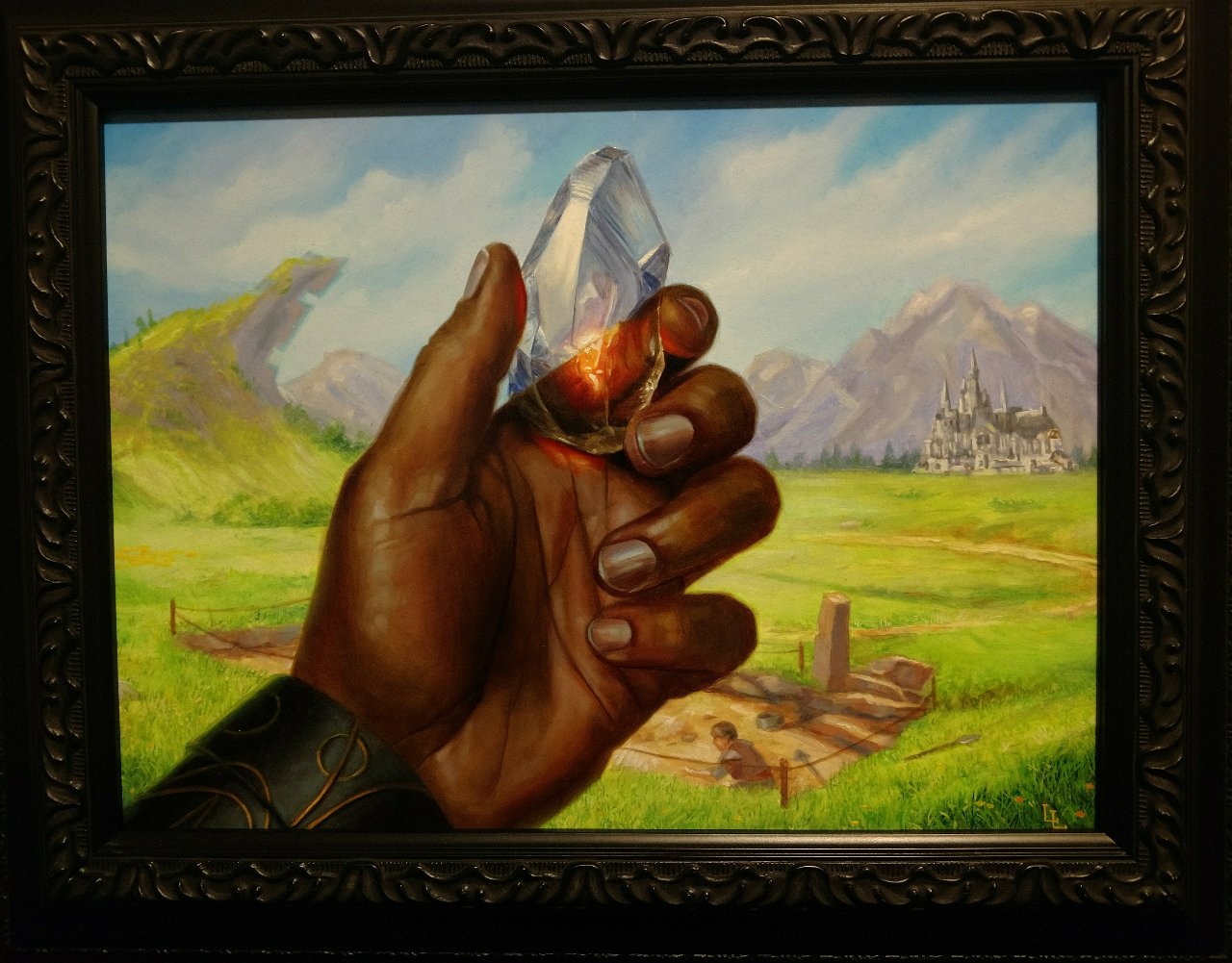
Powerstone Shard, oil on illustration board, 10.5” x 14”
The Artist
Lindsey Look has illustrated fifteen cards for Magic as of Powerstone Shard. She has graciously agreed to answer some questions about her career both within and outside of Magic, as well as provide some insight into the process and progression for Powerstone Shard. Let’s meet her!
For those readers that may not know you, can you introduce yourself and talk about some of your work? Who are you, where are you from, and what do you do?
Hi there! My name is Lindsey Look, and I’m a science-fiction & fantasy illustrator from Connecticut. I work traditionally in oil paint, and I make book covers, card game art, bad jokes, and 2 AM trips to Taco Bell.
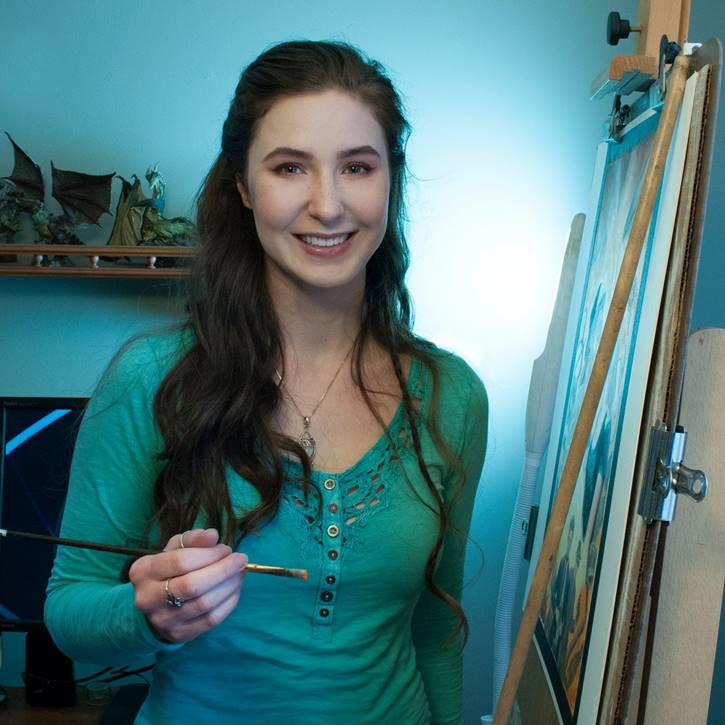
Photo courtesy of the artist.
Well between bad jokes and Taco Bell, you’ll find yourself right at home here in The Mirror Gallery.
Who would you consider your artistic influences?
If you’d asked me a year or so ago, I’d tell you Bouguereau, Moebius, Michael Whelan, Dean Cornwell, Arthur Rackham, the Orientalists… I’ve actually run out of room on my shelves for art books.
But lately, I’ve been trying to be less influenced by other artists and more by the world around me. When I was painting the background for Powerstone, it was mid-May (2017), and I was in the mountains in Massachusetts, SURROUNDED by green fields and blue skies. And instead of glancing outside, I was glancing at a computer screen and googling “landscape art”. It was ridiculous. I still love my books and looking at art but I’ve made a concerted effort since then to stop referring to how other artists paint, and just paint the thing.
Any Magic artists/particular Magic art you are a big fan of?
To be frank, I’m a fan of everyone. How’s that for a PC answer, haha? But it’s true. There’s so much work that goes into creating each set and making it a cohesive, beautiful end product, I have nothing but admiration for anyone that contributes.
So how did you get started working with Magic?
Oh, man. This sort of leads into your next question too. I’d known MTG artist Steve Belledin for a while, and unbeknownst to me, he’d kindly mentioned my name to Jeremy Jarvis, the art director at Wizards at the time. I got an email from Jeremy asking if I’d be interested in doing some Magic: the Gathering cards. What idiot would ever say no??? So obviously I agreed, and I got an email back which basically said, “Cool! Here’s six cards!”
Cue the sound of me having a full-blown panic attack. And not only was it six cards, it was the Diamond cycle: Lion’s Eye, Moss, Sky, Fire, Marble, and Charcoal Diamond. OH, OKAY, NO PRESSURE OR ANYTHING, Wizards of the Coast!!!
That’s incredible—six cards for your first commission including the treasured Lion’s Eye Diamond. Tell me more.
Initially, all six cards were used for MtGO, but they also (with the exception of Lion’s Eye) got printed in Commander 2014. Jeremy gave me a few extra weeks to work on them, which helped to ease my first-timers anxiety.
Besides the request for hands holding large gems, there wasn’t a specific plane or past card I needed to reference. I only needed to keep the backgrounds of the cards consistent in location- either an interior or exterior setting.
I purchased a bunch of colored glass paperweights and ended up convincing family and friends to, uh, lend a hand with reference shooting. That’s my mom’s hand you see in Lion’s Eye Diamond, my dad’s in Fire Diamond, and my grandmother’s in Charcoal. I love that I was able to immortalize the people in my life in my first set of cards.
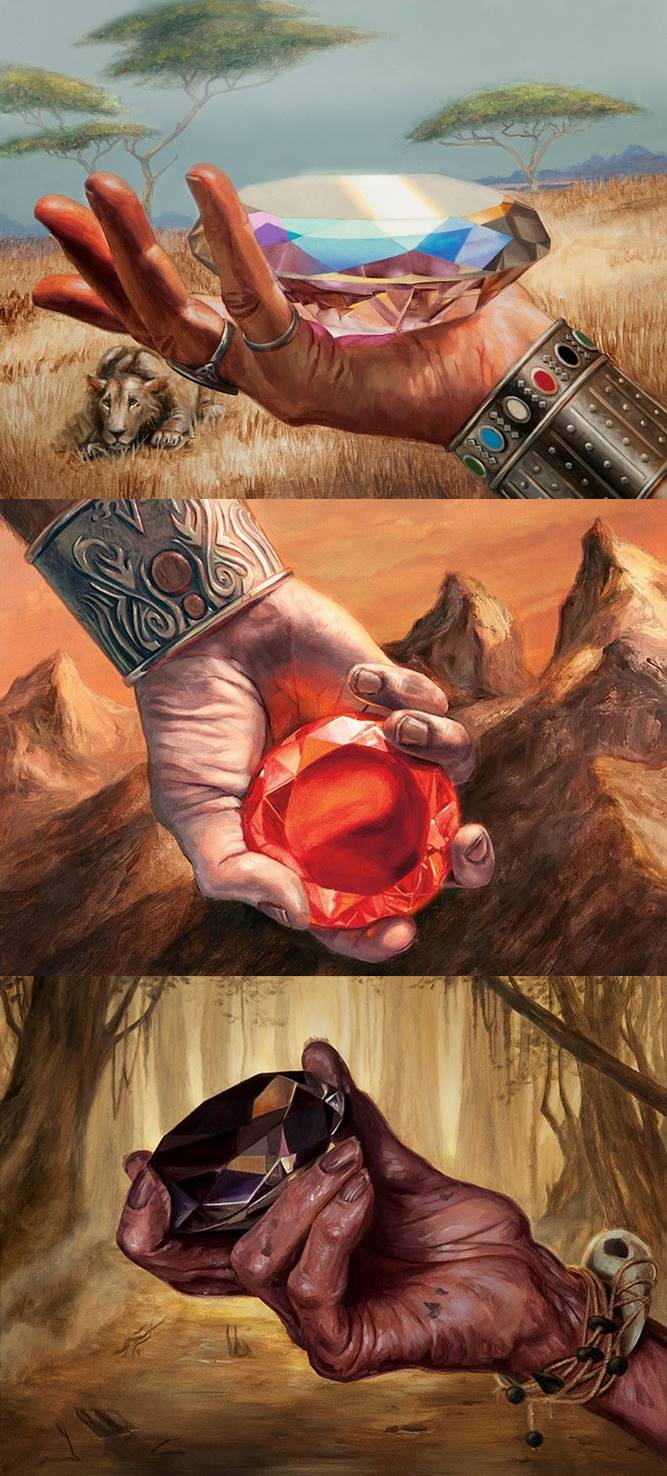
Lion’s Eye Diamond, Fire Diamond, Charcoal Diamond, all by Lindsey Look, Traditional.
I love hearing these stories about the things the cards simply can’t tell us. What has been your favorite card to illustrate for Magic so far and why?
Mystical Tutor was my favorite, not just because it’s such a useful card with a pretty fantastic history, but from a totally aesthetic perspective as well. I love the color combinations of blue-green, bright gold, and that dark, almost purple-brown. Sometimes getting the colors and contrast to work in a piece takes a fair amount of effort and fine-tuning, but this painting just worked from the beginning.
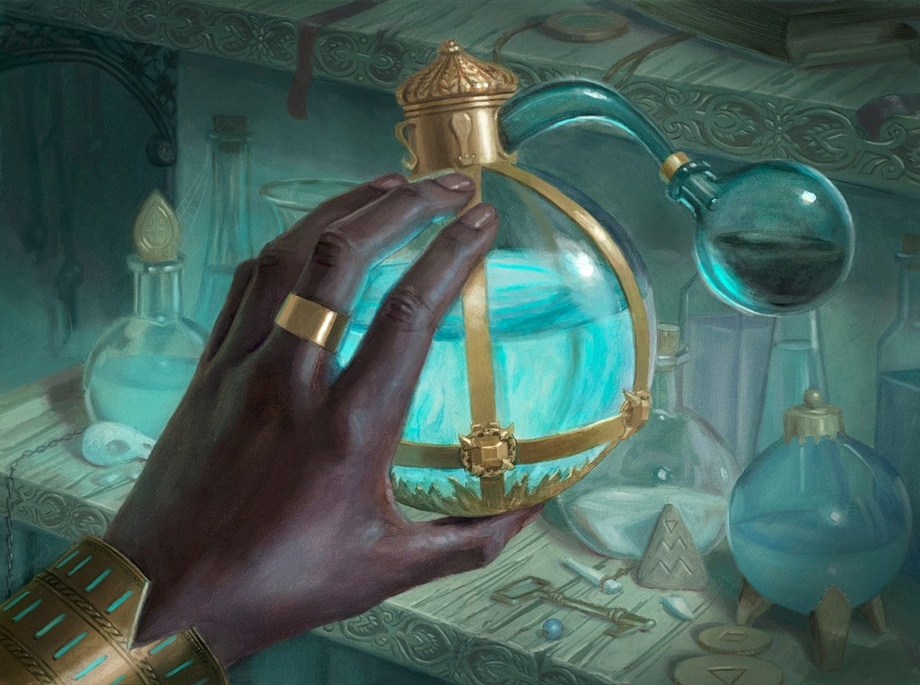
Mystical Tutor by Lindsey Look, Traditional, Original Sold.
Do you collect art, Magic or otherwise, or have any pieces on your walls you particularly love from other artists?
I wish I had the income to invest in original art! Hopefully someday! For now, I’ve got lots of prints hanging. J.A.W. Cooper, John Jude Palencar, Donato Giancola, and Michael Whelan are featured a few times on my walls.
Creating Powerstone Shard
Before you even start a sketch or painting, what in addition to the brief do you use for inspiration?
Wizards of the Coast compiles a giant digital book of references for each set, filled with illustration concepts and details for artists to use [style guide]. Most of the time, the art director will have the artist directly reference specific illustrations in the book, so that’s usually the first place I go. If I’m working on a reprinted card, I always look at the older edition to see if there are any fun little nods I can make to the previous image.
Can you share the art brief for Powerstone Shard, or talk about some of the components that Mark was looking for?
For Powerstone Shard, the brief called for a hand holding up a shard of powerstone, newly discovered during an archeological dig. There needed to be a faint glow of residual magic coming from within the stone. Mark also wanted the image to reference Urza’s Filter, so we purposely went with a similar composition—a straight-on horizon line, with the hand leading in from the left corner.
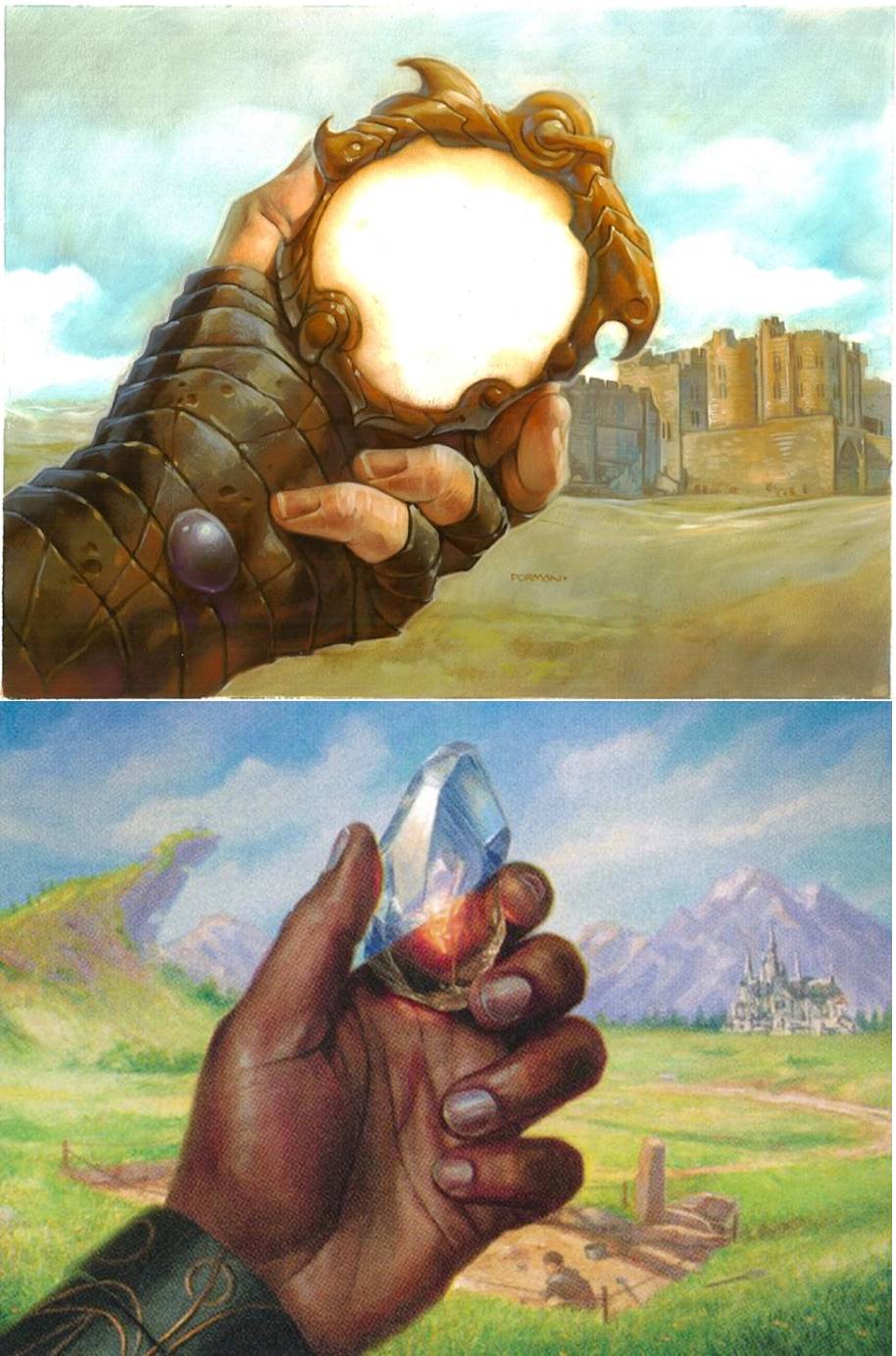
Top: Urza’s Filter by Dave Dorman, Traditional, approx. 9” x 11” Bottom: Powerstone Shard by Lindsey Look, oil on illustration board, 10.5” x 14”
Sidebar: You noticed how the final painting of Urza’s Filter doesn’t match the card? This happens more often than you think, as some pieces are finished digitally, or are composed of traditional pieces assembled digitally. More on this in a future article.
The nod to Urza’s filter makes a ton of sense, and the flavor text really reinforces that connection.
It does!

Powerstones are pretty important to Magic history. What did you use for reference material to capture the “powerstone?”
I ended up needing a few things! I used a quartz crystal to get the shape right, but it wasn’t as translucent as I wanted it to be. When I photographed the model, I had them hold a piece of glass slag, which had the right size and transparency (but not enough hard edges!). It often takes referencing multiple ordinary objects to make a Magic: the Gathering artifact come to life!
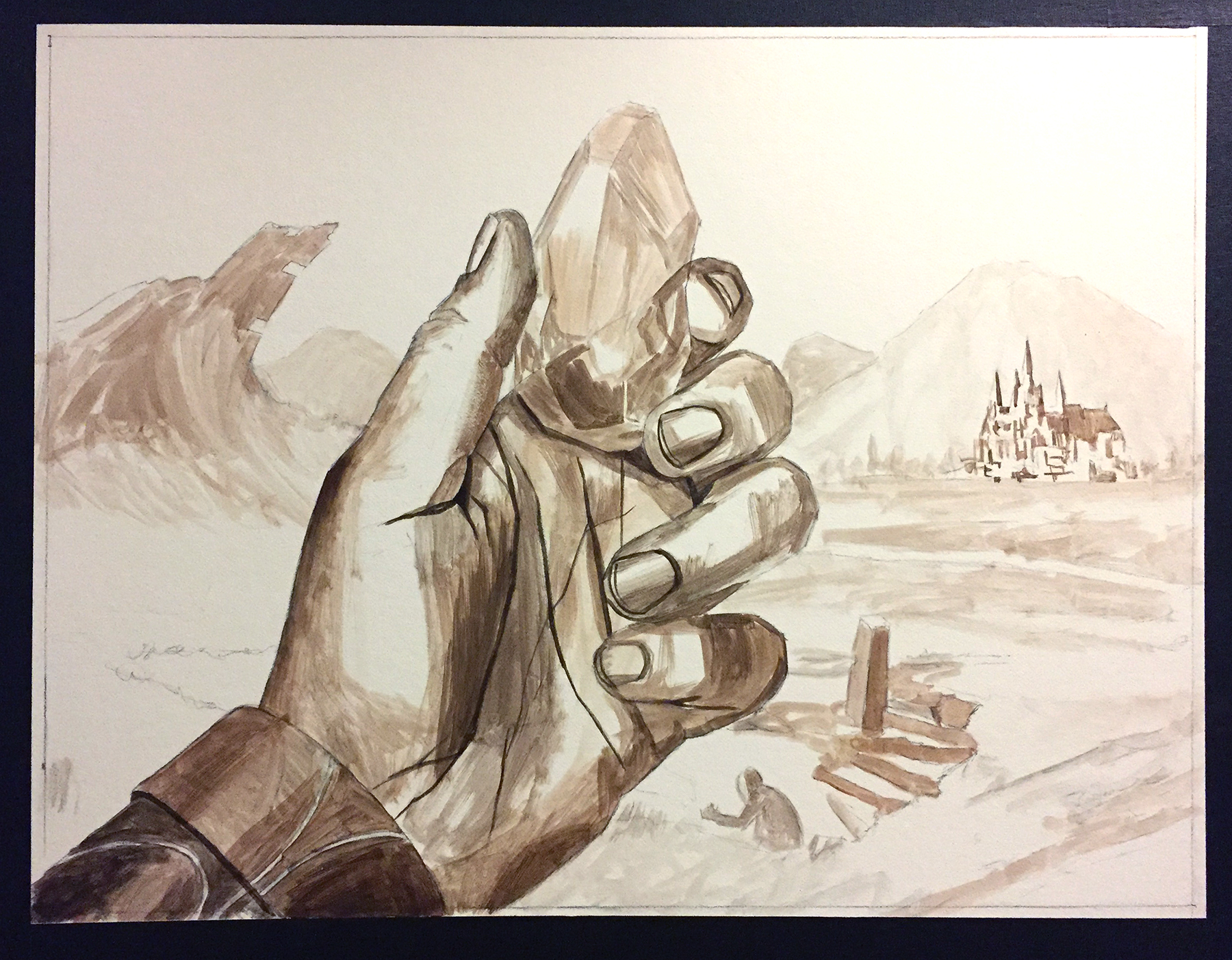
Image courtesy of the artist.
Did you do any research on Teferi—I’m thinking that could be him—before you started? And I’m guessing you used a hand model as well?
Teferi’s the one with the fire and goggles, right? (Kidding). The brief didn’t specifically mention Teferi, but there were a few descriptors, and given the storyline, it might be him. I do know Teferi’s basic story, but given Magic’s rich history, I feel like a hopelessly lost newbie ALL THE TIME. If there are specific planes or characters involved with the card, I definitely hop on the internet to do some research beforehand.
And yes, I always use a model, even if it’s just for a hand. And I’ve done so many artifacts at this point that I’ve mentally cataloged the hands of everyone I know for possible future cards.
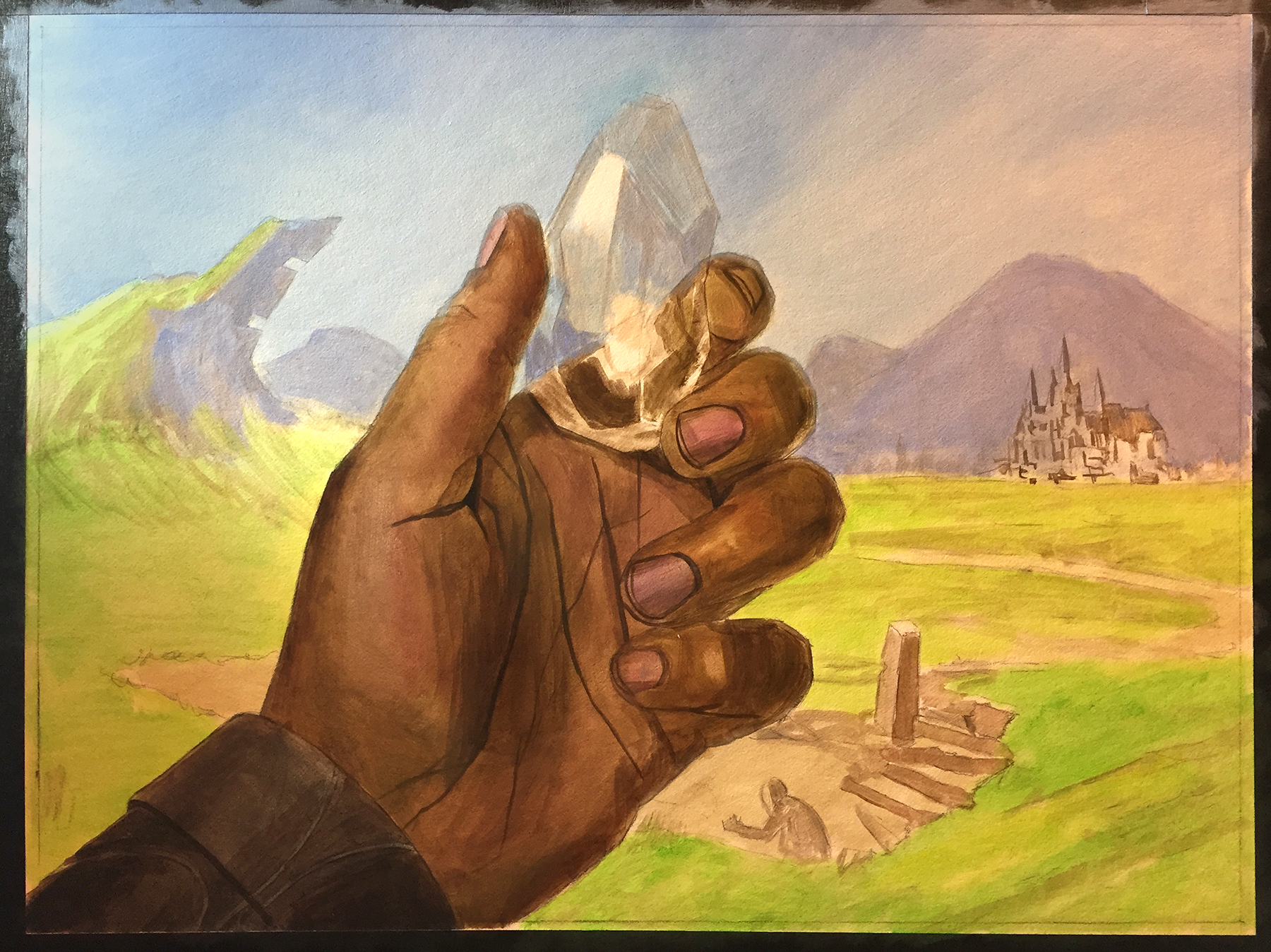
Image courtesy of the artist.
We have seen you paint pieces for settings in Tarkir, Innistrad, Kaladesh, and Amonkhet, as well as for Commander 2014. What made Dominaria different?
As an artist who used to steal her kid brother’s cards in the 90’s to look at the artwork, it was an honor to get to paint in the setting where Magic had its beginning. It was also one of the more lush sets I’ve worked on, and I love that we were able to see Dominaria regrow and rebuild itself over the ruins.
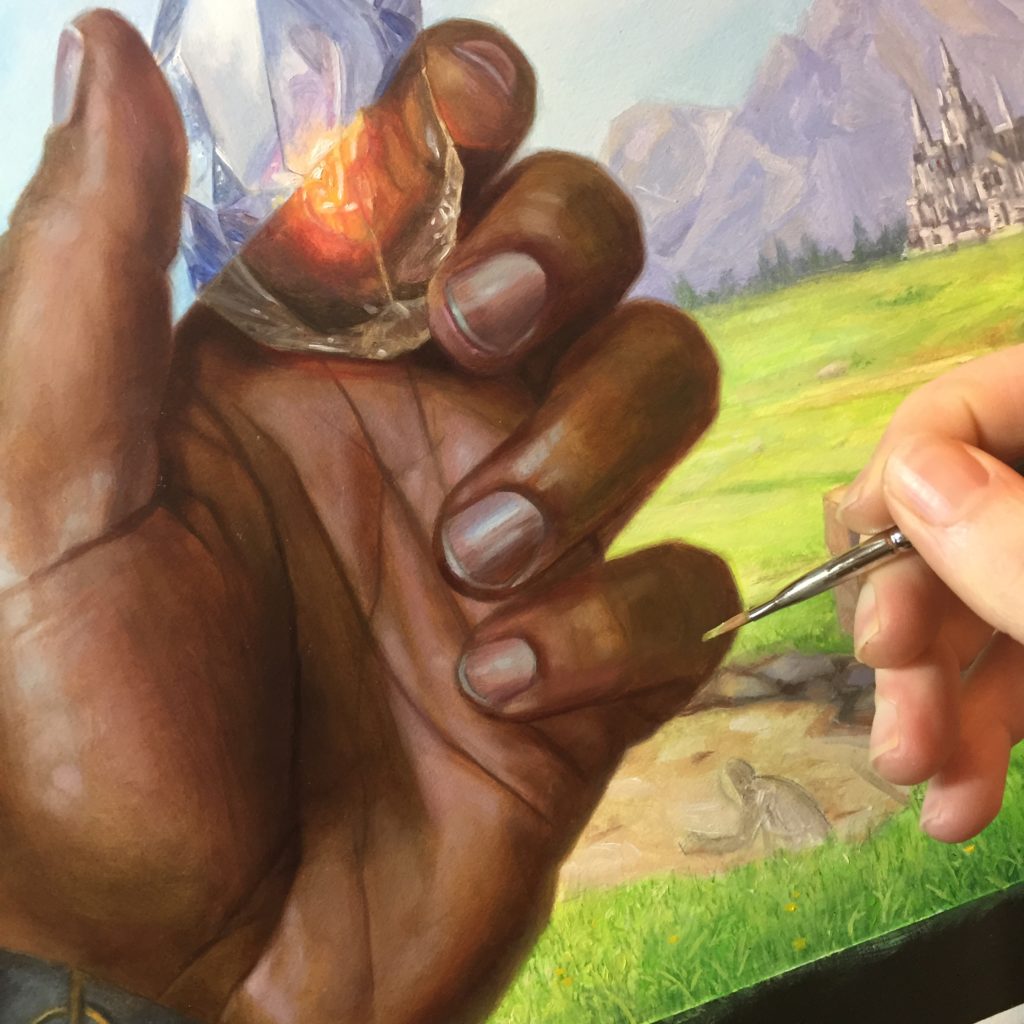
Image courtesy of the artist.
Dominaria is “home” for artists, too. I love it.
Now that we know a bit more about Lindsey and how she created Powerstone Shard, I’ll explain exactly why I fell in love with this piece of art.
Why This Piece?
The Work
Do you ever see something on the internet and really like it, only to receive it, hold it in your hands, and find that it’s even more incredible in real life?
That’s exactly what happened here. At card size, the piece is beautiful, with (possibly) Teferi holding a shard of powerstone overlooking a classic Dominarian landscape of mountains and manor. But in person, the original painting is even brighter, and at 10.5 by 14 inches, the detail not available at card size is nothing short of outstanding. From the artist’s brilliant execution of the hand and cuff to the dancing energy inside the shard, this art is a masterstroke. And as a bonus, it passes the Sofa Test with flying colors.
The Artist
As I was researching Lindsey’s body of work for this article, I came across a write up about Mystical Tutor by Mike Linnemann in his Eternal Masters art review. He notes that there is no longer a “hand artist” for Magic, but instead a short list of artists tapped to do such pieces. Lindsey’s name is at the top of this list, placing her alongside the likes of Donato Giancola and Volkan Baga, two living masters and high company indeed.
Her work outside of Magic has appeared in multiple volumes of Spectrum: The Best in Fantastic Contemporary Art, and I would estimate her Magic work will not be far behind. She is undoubtedly an artist to watch as she continues illustrating for Magic, and I am ecstatic to have the opportunity to add one of her originals to my collection.
The Environment
I can’t remember a time in my fifteen years of playing Magic seeing players so excited for a world, new or returning, as they have been for Dominaria. The story, art, cards, characters, and world have all gotten a ton of extremely positive praise, and Magic’s return to Dominaria is nothing short of legendary. I believe this set will be beloved for a long time, and owning a piece of art from Magic’s return to Dominaria is something I hoped to do since I heard we were going “home.”
To recap: Powerstone Shard is an exemplary example of what this artist is known for, set on Magic’s most hallowed plane, featuring a known and lore-important artifact being (potentially) held in the hand of one of the multiverse’s most important characters. There really isn’t anything else I could ask for in a painting.
Put it on the Wall!
For the first time in my Magic art collecting journey, a piece of artwork came into my collection already framed by the artist.
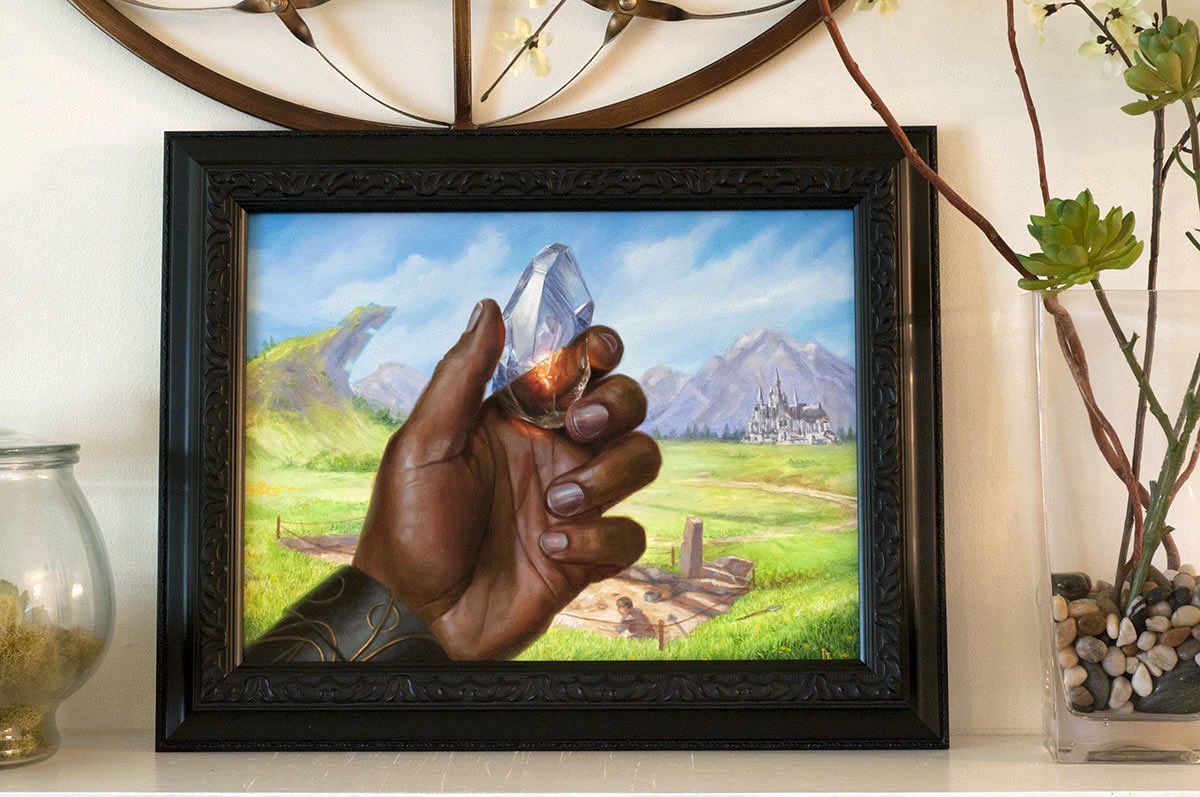
Image courtesy of the artist.
This means a couple of things:
1.) The artist has chosen this frame as an appropriate extension of her work. Art is generally not framed by accident; and if an artist is selling their work in a frame, you can bet that they find it appropriate and fitting for that work. This doesn’t mean that you cannot change the frame, but it’s something to consider.
2.) The work does not need to be framed upon my acquisition, which in some cases means that I can afford to spend a bit more in order to acquire the piece. Custom framing, as I alluded to in previous articles, does come at a price for being tailor-made to a piece of art, so having a frame included is worth accounting for in your art budget.
As of right now I have no intention of re-framing Powerstone Shard. I think Lindsey has done a wonderful job of framing this piece; the frame is fittingly simple yet it’s ornamentation invokes that Dominarian style depicted in the cuff. Perfect.
Build Your Collection
Lindsey has several finished originals still available for sale. As of right now, her preliminary work is done digitally and she paints directly over her initial sketch, so the final painting is the only option for collecting a piece of her Magic work. She has indicated she may change this process in the future, but for all her work in the past, the final is all that exists. Let’s find out what she has planned for the future:
Are we going to be seeing more Magic illustrations from you down the road?
Definitely! There’s a big gap of months where I couldn’t take any work due to an injury, but I’m doing better now and you should start seeing more of my work next year!
Fantastic! And you still have several Magic originals available, correct? Anything fun or special we should know about them?
Yes, I still have Guardian Shield-Bearer, Hapatra’s Mark, Rush of Vitality, and Wolfkin Bond, and they’re all oil on board. Fun fact—I used my brother-in-law and my Siberian Husky as reference in Wolfkin Bond. (Who posed as the human, and who was the wolf? You’ll never know!)
Where can people find you on the web if they want to talk art, buy stuff, or see what you’re up to?
I’m pretty good about updating Facebook and Twitter (@LindseyLook) if you want to stop by and chat or just see what I’ve been up to! Posters, artist proofs, and other fun things (Lion’s Eye Diamond playmat, anyone?) are available through my website, www.LindseyLook.com!
As mentioned, here is what is currently available from the artist if you are interested in adding a Lindsey Look original to your collection:
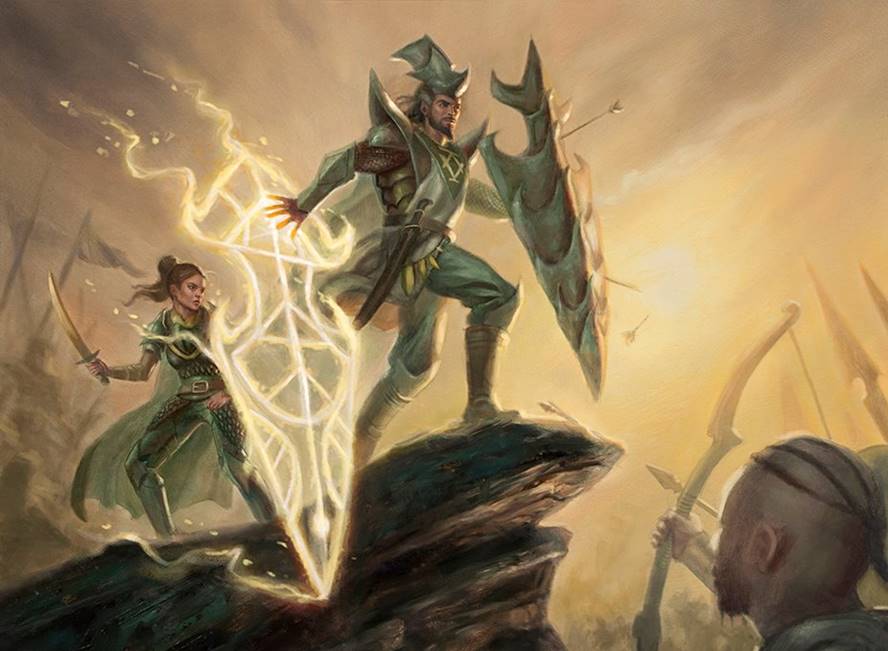
Guardian Shield-Bearer, oil on board, 12” x 16” $1000
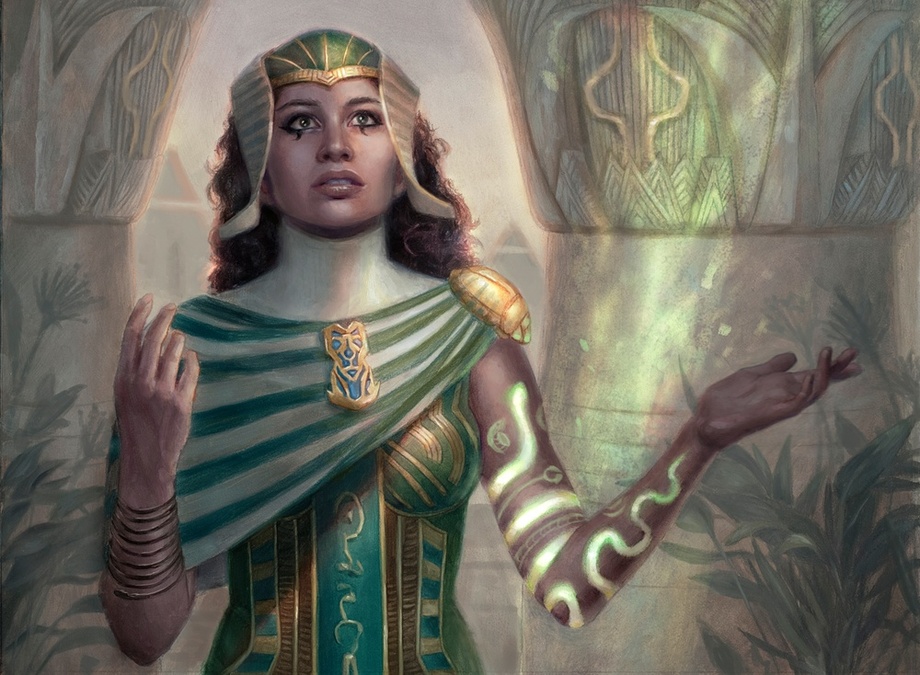
Hapatra’s Mark, oil on board, 11” x 14” $1500
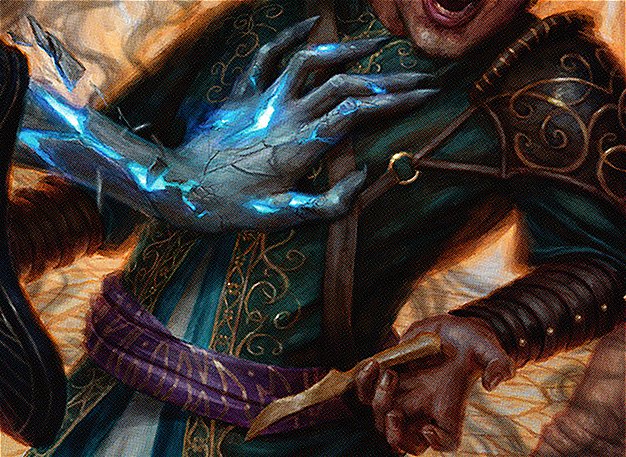
Rush of Vitality, oil on board, 9” x 12” $1500
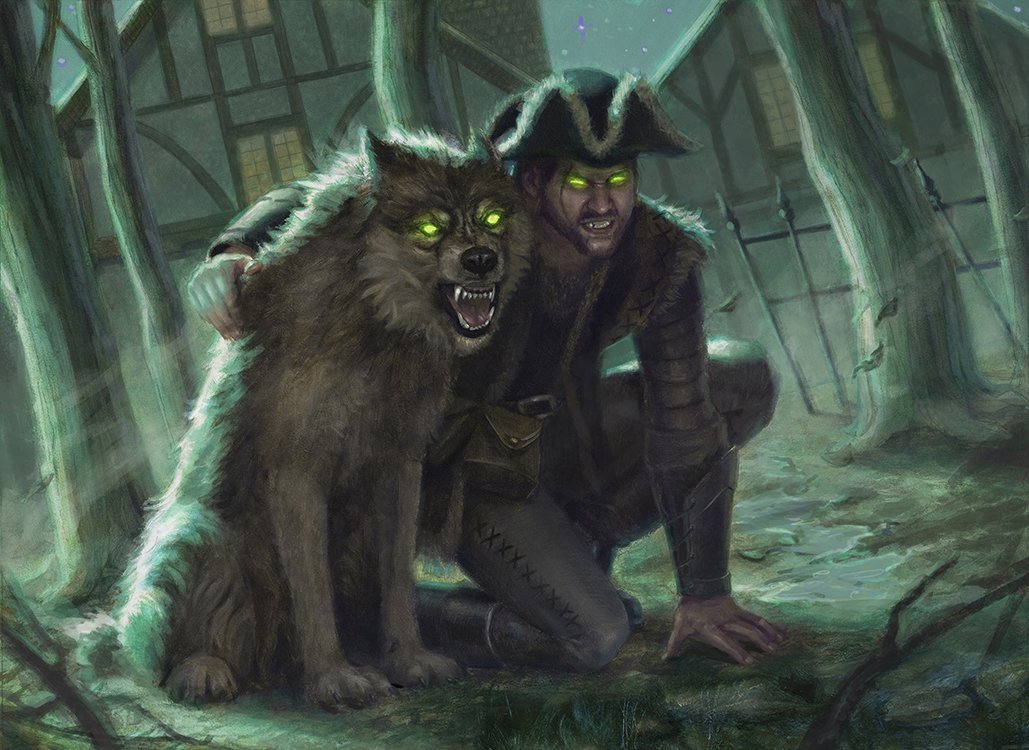
Wolfkin Bond, oil on board, 11” x 15.5” $1500
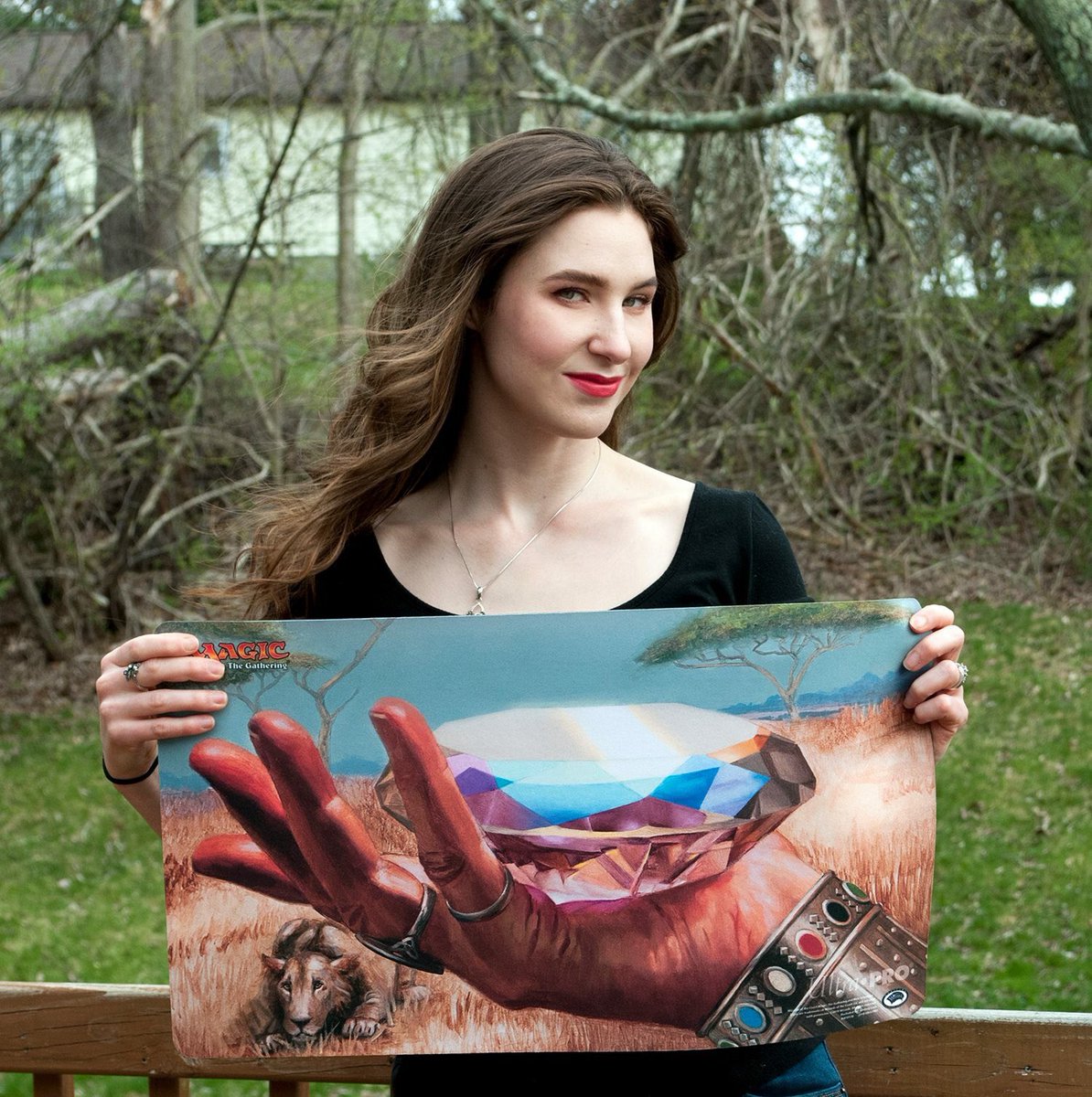
*NEW* Lion’s Eye Diamond Playmat, signed by the artist. $40
I have one of her Lion’s Eye Diamond playmats and I must say it printed beautifully. You will not be disappointed.

Playing Vintage Artist Constructed, Mono-Red Cavotta, at Grand Prix Washington, DC.
Wrapping Up
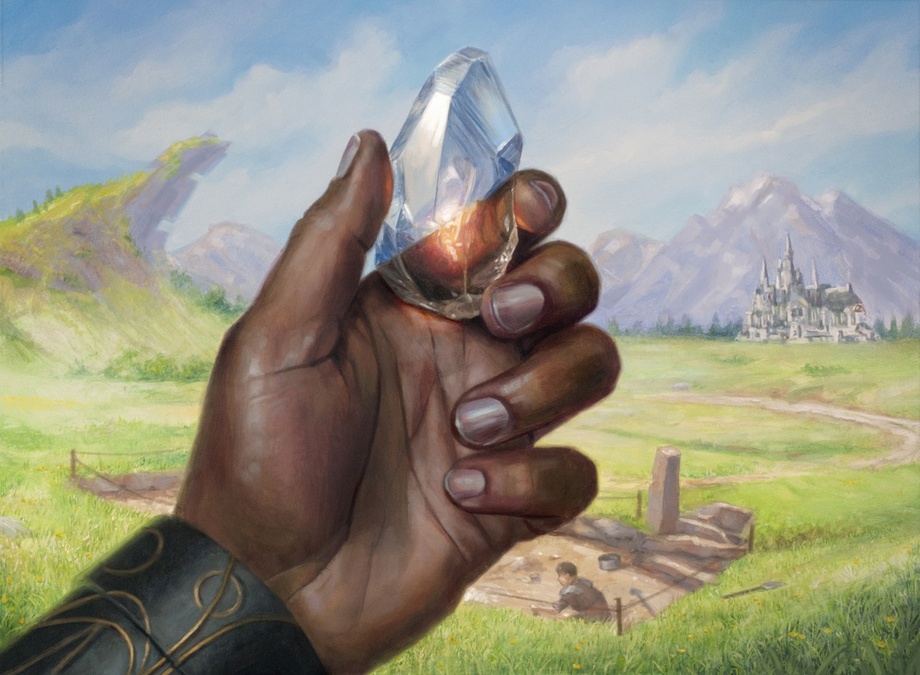
I truly hope you enjoyed this very special edition of The Mirror Gallery, and thanks again to Lindsey Look for providing such wonderful insight into this Dominarian masterpiece. This will be the first two-part article I have done, and next time we are going to look at how Powerstone Shard fits into a larger perspective of Magic art. I mentioned the company that being a “hand artist of Magic” includes, and we are going to take a quick look at the rich tradition of this aesthetic throughout the history of the game.
Remember, to see original #mtgart and other #vorthos related things, follow me on Twitter. Feel free to ask questions or retweet to continue the conversation. Thanks and see you next time!
Donny Caltrider has been playing Magic since 2002 and collecting original Magic art since 2017. He has an M.A. in Museum Studies from Johns Hopkins University and enjoys telling stories about art, objects, and the intersection of fantasy with real-life. You can find him on Twitter talking about #mtgart, museums, and other #vorthos related goodness. Follow along and continue the conversation!

